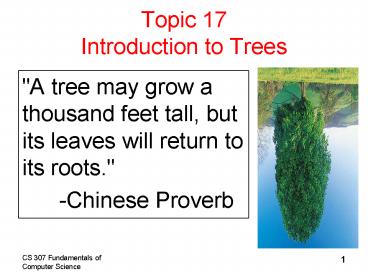Topic 17 Introduction to Trees - PowerPoint PPT Presentation
Title:
Topic 17 Introduction to Trees
Description:
Topic 17 Introduction to Trees – PowerPoint PPT presentation
Number of Views:33
Avg rating:3.0/5.0
Title: Topic 17 Introduction to Trees
1
Topic 17Introduction to Trees
- "A tree may grow a thousand feet tall, but its
leaves will return to its roots." - -Chinese Proverb
2
Definitions
- A tree is an abstract data type
- one entry point, the root
- Each node is either a leaf or an internal node
- An internal node has 1 or more children, nodes
that can be reached directly from that internal
node. - The internal node is said to be the parent of its
child nodes
root node
internalnodes
leaf nodes
3
Properties of Trees
- Only access point is the root
- All nodes, except the root, have one parent
- like the inheritance hierarchy in Java
- Traditionally trees drawn upside down
root
leaves
4
Properties of Trees and Nodes
root
- siblings two nodes that have the same parent
- edge the link from one node to another
- path length the number of edges that must be
traversed to get from one node to another
edge
siblings
path length from root to thisnode is 3
5
More Properties of Trees
- depth the path length from the root of the tree
to this node - height of a node The maximum distance (path
length) of any leaf from this node - a leaf has a height of 0
- the height of a tree is the height of the root of
that tree - descendants any nodes that can be reached via 1
or more edges from this node - ancestors any nodes for which this node is a
descendant
6
Tree Visualization
7
Attendance Question 1
- What is the depth of the node that contains M on
the previous slide? - -1
- 0
- 1
- 2
- 3
8
Binary Trees
- There are many variations on trees but we will
work with binary trees - binary tree a tree with at most two children for
each node - the possible children are normally referred to as
the left and right child
parent
right child
left child
9
Full Binary Tree
- full binary tree a binary tree is which each
node was exactly 2 or 0 children
10
Complete Binary Tree
- complete binary tree a binary tree in which
every level, except possibly the deepest is
completely filled. At depth n, the height of the
tree, all nodes are as far left as possible
Where would the next node goto maintain a
complete tree?
11
Perfect Binary Tree
- perfect binary tree a binary tree with all leaf
nodes at the same depth. All internal nodes have
exactly two children. - a perfect binary tree has the maximum number of
nodes for a given height - a perfect binary tree has 2(n1) - 1 nodes where
n is the height of a tree - height 0 -gt 1 node
- height 1 -gt 3 nodes
- height 2 -gt 7 nodes
- height 3 -gt 15 nodes
12
A Binary Node class
public class BNode private Object
myData private BNode myLeft private BNode
myRight public BNode() public BNode(Object
data, BNode left, BNode right) public Object
getData() public BNode getLeft() public BNode
getRight() public void setData(Object
data) public void setLeft(BNode left) public
void setRight(BNode right)
13
Binary Tree Traversals
- Many algorithms require all nodes of a binary
tree be visited and the contents of each node
processed. - There are 4 traditional types of traversals
- preorder traversal process the root, then
process all sub trees (left to right) - in order traversal process the left sub tree,
process the root, process the right sub tree - post order traversal process the left sub tree,
process the right sub tree, then process the root - level order traversal starting from the root of
a tree, process all nodes at the same depth from
left to right, then proceed to the nodes at the
next depth.
14
Results of Traversals
- To determine the results of a traversal on a
given tree draw a path around the tree. - start on the left side of the root and trace
around the tree. The path should stay close to
the tree.
12
pre order process when pass down left side of
node12 49 13 5 42 in order process when
passunderneath node13 49 5 12 42 post order
process when pass up right side of node13 5 49
42 12
49
42
13
5
15
Tree Traversals
16
Attendance Question 2
- What is a the result of a post order traversal of
the tree on the previous slide? - F C G A K H L D J
- F G C K L H J D A
- A C F G D H K L J
- A C D F G H J K L
- L K J H G F D C A
17
Implement Traversals
- Implement preorder, inorder, and post order
traversal - Big O time and space?
- Implement a level order traversal using a queue
- Big O time and space?
- Implement a level order traversal without a queue
- target depth
- Different kinds of Iterators for traversals?































